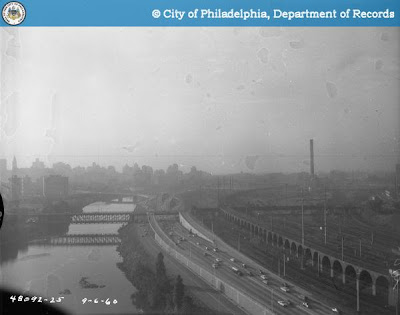Callowhill Street Bridge (aka Fairmount Bridge, aka Spring Garden Street Bridge)
Spanning the Schuylkill River at Callowhill and Spring Garden Streets
 |
| 1890. That's a nice looking bridge right there. |
This bridge was built to make all previous Schuylkill River bridges look like dead racoon's ass. This beast was designed to be the most badass bridge that people had ever seen, and for awhile, lived up to that requirement.
With the super-awesome Centennial Exhibition approaching, Philadelphia needed cool new shit to show off for the multitude of guests from around the world that would be visiting the city. The iconic Wire Bridge at Fairmount was getting old at this point and the retro look was definitely not in. The Centennial Exhibition was about innovation and the future. Let the shitty-ass Sesquicentennial Exhibition be about the past.
They took down the kick-ass
Wire Bridge at Fairmount and contracted famous bridge engineer J. H. Linville and the Keystone Bridge Company to design a super kickasstastic mega bridge that would stand out as the finest and most high-tech in the union. Linville pulled out all the stops and designed a double-decked rail and pedestrian bridge that connected Callowhill Street AND Spring Garden Street on either side of the river. It would be 48 feet wide, running 1,254 feet, (350 over the river) with 2,730 foot approaches on either side.
The approaches were designed by Strickland Kneass and pissed Linville the fuck off. Linville didn't want the bridge to have decorated arches because then it would look way too cool, but Kneass went ahead and made the approaches all arched, so Linville was forced to continue the arches through the bridge structure. Just to be an asshole, he created a Whipple Truss wrought iron superstructure and tacked some non-weightbearing cast iron arches along the sides.
Construction began in 1874 and the bridge opened in 1875. The pricetag? 1.2 million dollars... a ridiculously high amount for the time.
 |
| Under construction. |
Once complete, people loved this fucking thing. The railroad ran on the upper deck and carriages/pedestrians ran on the lower. Tourist guides from the era actually encouraged visitors to get off their trains, walk across the lower deck, and reboard the train on the other side.
 |
| Approach to the lower level. They sure don't make 'em like this anymore. |
The wrought iron framework and the cast iron arches were extremely vulnerable to rust. The bridge rusted right up shortly after it was built. The motherfucker was turning orange and by 1885, big-ass chunks of rust were falling from the upper deck to the lower deck. It got so bad that they had to employ motherfuckers who would clean off the fallen chunks.
By 1900, people had enough of this shit. The cast iron arches on the bridge were removed and a new metal framework was built for the approaches. For the rest of its existence, the bridge would expose its less-exciting wrought iron Whipple Trusses.
 |
| 1904 view of De-Arched Callowhill Street Bridge |
By 1917, everyone forgot about the grandeur of the original bridge. They even forgot its name... they started calling it the Spring Garden Bridge instead. Talk of widening or rebuilding the bridge began at about this time, but never happened.
 |
| The Lower Deck in 1954. |
The span stayed in continuous use until Interstate 76 was built and started to get in the way of the lower deck. In the mid 60's, a plan to add a Spring Garden Street exit from the highway was created, and the old girl wasn't up to the task of having that kind of connection. In 1964, the 89 year old bridge was lowered onto a barge and hauled away. A plaque commemorating this bridge is present on the new one, but the illustration on it shows the crappy Whipple Truss version.
This bridge shows how something that was cool as fuck in 1875 could be considered a piece of shit only 20-some years later. The next time you go over the modern highway-ramp style version of this bridge, make sure to piss out the window in honor of its great predecessor.
 |
| 1960 skyline view from the last years of the Callowhill Street Bridge. |













